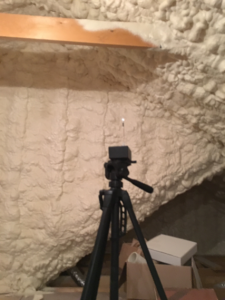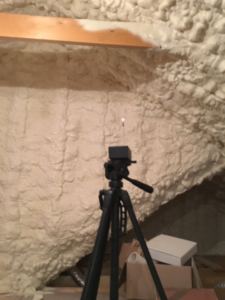Most of us are already familiar with the nutritional and environmental benefits of soy as a food product. However few people realize that this versatile plant also has a potentially valuable role to play in home construction. For those who are interested in safe and sustainable “green” architecture, soy-based spray insulation may offer a viable alternative to conventional polyurethane insulation; however, there are a few caveats to consider before making the switch.
The Problem With Polyurethane: Understanding The Dangers Of Conventional Spray Insulation
Polyurethane (a type of soft, springy plastic) is found in everything from foam mattresses and pillows to bowling bowls, and it’s generally considered safe for human use. Though liquid polyurethane contains a number of toxic volatile organic compounds (VOCs), when it has fully “cured,” it’s supposed to be chemically stable and inert. Unfortunately, not all polyurethane products are created equal, and in recent years it has come to light that certain polyurethane products—namely adhesives, coatings, and spray foam—may never fully “cure”. This means that polyurethane spray insulation may continue to release VOCs into our homes and offices for many years after it is applied.[1]
Though the manufacturers of polyurethane spray foam insulation claim that it is entirely safe, the Environmental Protection Agency (EPA) says otherwise. According to the EPA, “The potential for off-gassing of volatile chemicals from spray polyurethane foam is not fully understood and is an area where more research is needed”.
Additionally, the EPA warns that exposure to the VOCs in polyurethane insulation can cause:
- Asthma;
- Sensitization;
- Lung damage;
- Other respiratory and breathing problems;
- Skin and eye irritation.
Adding to the potential long-term health effects of polyurethane insulation, many VOCs are also highly carcinogenic.[2]

Verifying the EPA’s suspicions, some homeowners have already experienced the risks of polyurethane insulation firsthand. Take, for example, a case recorded in the March 2012 edition of the Journal of Occupational and Environmental Medicine by Dr. Yuh-Chin, T. Huang and Dr. Wayne Tsuang. According to the report, a couple in their 30s who returned to their home after spray foam was installed in the attic began experiencing difficulty breathing, coughing, nausea, headaches and watery eyes almost immediately after re-entering the house. When they sought medical attention, they were both diagnosed with asthma triggered by isocyanate, one of the primary VOCs released by polyurethane insulation. “The use of [spray polyurethane foam] in residential homes likely will continue to increase,” wrote the doctors in the report. “This new source of exposure potentially puts a large population at risk for adverse health effects”. The couple’s symptoms were so severe that they were forced to leave their home and remove all of the insulation they had just installed.
Since the journal was published, Dr. Huang has reportedly been contacted by more than a dozen people who have reacted similarly to polyurethane spray foam. Almost all of these people have been unable to safely return to their homes.[3]
Soy Insulation: The Safe Alternative, Or an Unsound Investment?
Soy insulation, like all forms of “green” insulation, was developed with the aim of reducing humanity’s carbon footprint and reliance on fossil fuels. Polyurethane, like all plastics, is manufactured from petroleum products. In recent years, however, it’s also been studied as a safer alternative to polyurethane insulation owing to its reported lack of VOC off-gassing.
While there is little doubt that soy-based insulation is less toxic than polyurethane, according to the architecture experts at Horizon Builders, “[Though] the current soy products perform much better than fiberglass batts… there are some sacrifices with soy foam in that they don’t insulate as well as closed-cell polyurethane foam. While they are constantly being improved and may someday rate as high as the petroleum based products, current soy-based technology can’t compete on the same level and provide the same density of insulation or R-value as poly.”[4] This means that at least some of the environmental benefits of soy insulation are lost in the form of more resource expenditure while heating and cooling homes (though energy expenditure will still be far lower than what is required when using fiberglass insulation). Additionally, homeowners must pay more to regulate the temperature of their homes when they install soy vs. conventional polyurethane insulation.
Finally, contrary to popular belief, soy insulation is not 100% free of toxic chemicals; it does still contain at least some amount of urethane as urethane is still necessary to bind the insulation effectively. It merely contains a percentage of soy-based material, and this percentage varies from one manufacturer to another. So, it’s extremely important to verify just how “green” a soy-based foam product is before installing it in your home. (Note, however, that fiberglass batting also “off-gasses” toxic compounds, so choosing soy may still be the safest option vs. both fiberglass batting and pure polyurethane insulation.)[5]
In summation, choosing the right insulation for your home is all about weighing up the various advantages and risk factors of each type and deciding which option best suits your unique needs and preferences.
IndoorDoctor does not recommend using any form of spray foam insulation because we feel that:
- An increase in overall formaldehyde and chemical risk
- If it is applied incorrectly who is going to remove it and how? Typically, the homeowner is left high and dry with the cost to test, replace or retrofit
- SPF makes the home too tight without the necessary control measures such as added ventilation HRV/ERV
- Chemical exposure to residents is still too unknown. Science and helath advancements will likely show some form of an unknown health risk down the road.
[1] EPA Raises Health Concerns with Spray Foam Insulation, https://www.buildinggreen.com/blog/epa-raises-health-concerns-spray-foam-insulation
[2] Spray Polyurethane Foam (SPF) Insulation and How to Use it More Safely, https://www.epa.gov/saferchoice/spray-polyurethane-foam-spf-insulation-and-how-use-it-more-safely
[3] Losing their health and homes to spray polyurethane foam, http://www.treehugger.com/green-architecture/losing-their-health-and-homes-spray-polyurthane-foam.html
[4] Horizon Builders, http://www.horizonbuildersinc.net/archtip-issue1-tip3.html
[5] Soy Based Foam Insulation: What It Is, and Why You Should Use It, http://www.thegreenestdollar.com/2009/02/soy-based-foam-insulation-what-it-is-and-why-you-should-use-it/






